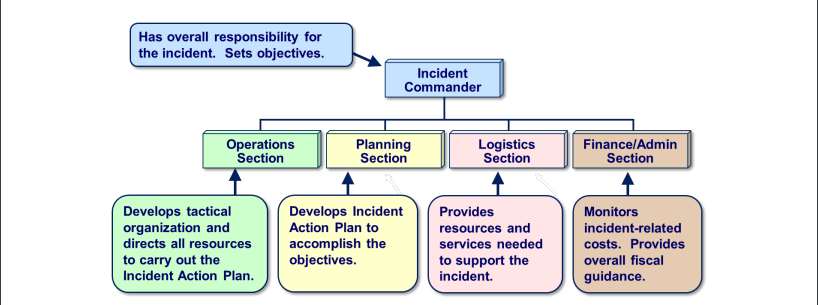147 Chapter Two – Lesson Four
Chapter Essential Questions
- What are the unique challenges faced by First Nation communities when responding to emergency situations such as floods, fires, mold in housing, and epidemic outbreaks?
- How can emergency responders effectively coordinate with First Nation communities during emergencies to provide adequate support?
- What resources and funding are available to support First Nation communities in preparing for and responding to emergency situations?
- How can First Nation communities work collaboratively with government agencies, non-governmental organizations, and other stakeholders to improve emergency response in their communities?
- What are the principles of the incident command structure and how is it utilized?
Lesson 4: Creating a strategy plan
Outcomes
By the end of this module, you should be able to:
- Describe what Incident Command Structure (ICS) is and how it can be used to create an official EAP;
- Create a chain of command (according to ICS) which lists name, position, duties and contact information and utilizes the official ICS Organizational Structure and Elements (command staff, section, branch division and group);
- Describe how to set up a volunteer emergency response team (that would be included in the chain of command ICS system) including training, meetings, and communication in the event of an emergency;
- Explain the importance of quick response during an emergency from an emergency response team;
- Discuss the importance of training an emergency response team.
What is Incident Command Structure and how can it be used for EAP
The Incident Command Structure (ICS) is a standardized approach to emergency management that provides a consistent framework for coordinating and managing emergency response activities. ICS is designed to facilitate effective communication, coordination, and collaboration among emergency responders, agencies, and organizations.
To create an official Emergency Action Plan (EAP), an organization can use the ICS structure as a framework to develop a plan that outlines the actions and procedures necessary to respond to an emergency or disaster. The plan should include clear roles and responsibilities, communication protocols, and procedures for responding to different types of incidents.
The ICS structure helps to ensure that the EAP is comprehensive and effective, as it provides a framework for integrating the different functional areas necessary for an effective response. By following the ICS structure, emergency responders, agencies, and organizations can work together more efficiently to coordinate the response efforts and mitigate the impact of an emergency or disaster.
The standardized on-site management system known as the Incident Command System (ICS) is designed to ensure seamless and efficient incident management. This is achieved through the integration of facilities, equipment, personnel, procedures, and communications under a common organizational structure.
The ICS can be utilized for small and large situations, including emergencies and non-emergency events. It offers guidance for organizing response assets and managing responses through various stages. The system is composed of five functional areas, namely Command, Operations, Planning, Logistics, and Administration/Finance. Each area has specific primary responsibilities that are outlined in Figure 1-3.

Figure 1-3
Creating a chain of command in your community
1. Identify the Incident Commander (IC) and Deputy IC: The IC should be the senior-most person who is responsible for managing the incident. The deputy IC will assume the role of IC if the IC becomes unavailable.
2. Establish the Command Staff: The IC should designate a Public Information Officer (PIO), a Safety Officer (SO) and a Liaison Officer (LO). Their position titles should be clearly defined.
3. Identify Sections: The IC should establish Sections (Operations, Planning, Logistics, and Finance/Administration) to manage different aspects of the incident. Each section should have a designated Section Chief.
4. Establish Branches or Divisions: The Section Chief should create Branches or Divisions to manage suboperations within their section. Each Branch/Division should have a designated Branch/Division Director.
5. Assign resources to Groups: The Branch/Division Director should organize their resources into Groups, each with a designated Group Supervisor.
6. Define Positions: Ensure each position is clearly defined in terms of duties and responsibilities.
7. Document Names and Contact Information: Assemble a list of all personnel involved in the incident, their positions, duties/responsibilities, and contact information.
8. Share the Chain of Command: Share the finalized chain of command with all personnel involved and communicate any changes as necessary.
9. Review Periodically: The chain of command should be reviewed and updated as necessary throughout the duration of the incident.
How to set up a volunteer emergency response team
A volunteer emergency response team is a group of individuals who are willing and able to assist in emergency situations. The team should be established as part of an overall emergency response plan within the Incident Command System (ICS) structure. The first step in setting up a volunteer emergency response team is to identify potential volunteers. This can be done by advertising through community organizations, social media, or word of mouth.
Once a team has been established, training should be provided to ensure that each member is adequately prepared to respond to emergencies. Training can include basic first aid, CPR, and disaster response procedures. Depending on the nature of the team’s responsibilities, additional training may be required, such as hazardous materials handling or search and rescue techniques. It is essential to ensure that all team members are adequately trained and that they are familiar with the ICS structure.
The team should hold regular meetings to review procedures and protocols and to discuss any issues that may arise. Meetings can also be used to identify areas for improvement and update the emergency response plan as necessary. It is important to ensure that communication channels are established so that team members can quickly and easily communicate with each other in the event of an emergency. This can be facilitated through phone, email, or social media groups.
Finally, the volunteer emergency response team should be integrated into the larger ICS structure. This may involve establishing a chain of command, assigning responsibilities, and defining roles and expectations. It is important to ensure that the team is adequately prepared to work within the ICS framework so that they can effectively communicate and coordinate with other emergency responders in the event of a disaster.
In conclusion, setting up a volunteer emergency response team requires identifying potential volunteers, providing appropriate training, holding regular meetings, establishing communication channels, and integrating the team into the ICS structure. By following these steps, a volunteer emergency response team can be an effective and valuable asset in responding to emergencies within a community.

Establishing a Community Emergency Response Team
Preparation, education, and vigilance are crucial in keeping communities safe from unexpected emergencies. Active involvement in education and response processes is one of the most effective ways to prepare people for emergencies within organizations. Establishing a Community Emergency Response Team (CERT) can enable citizens to become a vital part of their safety and preparedness.
CERTs consist of volunteer employees who participate in classroom exercises to learn critical emergency response skills. They commit to serving their workplace and community in the event of disaster when professional responders are unavailable. CERT members can provide valuable support to professional emergency teams, provide immediate assistance to victims, coordinate spontaneous volunteers, and improve community safety.
One should receive training from certified trainers to become a CERT member. The program goals for a CERT should include measurable elements such as the number of trainers and volunteers and launch date. A hazard analysis determines the types of risks the community may face to prioritize and tailor volunteer CERT team training.
Communication is vital in mobilizing volunteers immediately following a disaster. Critical information should be communicated to all registered volunteers to reduce the risk of misinformation. Spontaneous and unaffiliated volunteers should be distributed to community agencies and disaster relief organizations.
The Importance of quick response during an emergency from an emergency response team
During an emergency, every second counts and the quick response from an emergency response team can make a huge difference between life and death. The importance of a quick response cannot be overstated as it can determine the severity of the situation and minimize the damage caused. Whether it is a natural disaster, a terrorist attack, or a medical emergency, the emergency response team must act promptly to provide necessary assistance and prevent further harm.
A quick response from an emergency response team can save countless lives. The first responders are trained to react rapidly and make quick decisions under pressure. They are equipped with knowledge, skills, and tools to handle a wide variety of emergencies and apply the appropriate response to ensure the safety of the public. Quick thinking, problem-solving, and communication skills are essential to responding effectively to emergencies.
Furthermore, a quick response can help to prevent the situation from escalating. For instance, in a fire outbreak, the emergency response team must act fast to put out the fire before it gets out of control. In the case of a medical emergency, the team must act quickly to stabilize the patient to prevent the condition from worsening. In all types of emergencies, the sooner the emergency response team arrives, the better the chances of preventing further damage and saving lives.
Finally, a quick response from an emergency response team can help to calm people’s nerves amidst the chaos. During an emergency, people can feel helpless and scared, but a swift response from the emergency response team can provide reassurance that help is on the way. It can also communicate to the public that the situation is under control, providing a sense of safety and security.
In conclusion, a quick response from an emergency response team is crucial in dealing with emergencies. It minimizes the damage caused, saves lives, prevents the situation from escalating, and provides reassurance to the public. The emergency response team should be trained to act promptly and efficiently to ensure they can offer help when and where it is needed most.

Discuss the importance of training an emergency response team
Training an emergency response team is of utmost importance as it can save lives and reduce damage during an emergency situation. There are several reasons why it is necessary to train members of an emergency response team:
1. Rapid Response: An emergency response team that is well-trained can respond quickly to a crisis situation, minimizing the damage and saving lives. They are trained to act fast and effectively in various situations, such as natural disasters, terrorist attacks, and medical emergencies.
2. Safety: During emergencies, it is important to ensure the safety of those involved in the situation as well as those providing assistance. A well-trained emergency response team is equipped with the necessary knowledge and skills to ensure they are safe while providing aid.
3. Effective Communication: Clear communication is crucial in emergency situations, especially when there is a need to coordinate various responses. A trained emergency response team is proficient in communicating effectively, allowing for better coordination and response time.
4. Resource Management: An emergency response team is also trained to manage resources efficiently, such as equipment, human resources, and time. They can prioritize and allocate resources where they are most needed, ensuring maximum efficiency in the response process.
5. Crisis Management: Finally, a well-trained emergency response team is equipped to manage a crisis situation effectively, minimizing the impact on those involved and returning the situation to normalcy as soon as possible.
In conclusion, training an emergency response team is paramount to ensuring effective and timely responses during crisis situations. The importance of training cannot be overstated, as it is critical to prevent further loss of life and property during emergencies.
Journal Prompt
Using the forum labelled “Course 12: Chapter 2: Lesson 4” make a journal entry responding to the prompt below. Ensure that you title the entry “Chapter 2: Lesson 4”. Ensure that you title the entry “Lesson 4”. After writing a journal entry, go and make a comment on two other posts from your classmates. It can be about anything you noticed, liked, agreed with etc. The idea is to continue the dialogue about the topic.
Prompt: For this journal prompt, reflect on your understanding of the chain of command within the emergency action plan.
How does this structure impact communication and decision-making processes within the organization?
Have you identified any areas of improvement in the current structure that could enhance the efficiency and effectiveness of the EAP?
Describe a scenario in which you had to navigate the chain of command within the EAP.
What challenges did you face, and how did you handle them? What did you learn from this experience, and how will you apply this knowledge in the future to ensure a smoother communication and decision-making process within the EAP?
*View the journal entry and journal comment rubric to see how they will be marked.
| Criteria | Exemplary 4 |
Accomplished 3 |
Developing 2 |
Beginning 1 |
| Purpose | Strong voice and tone that clearly addresses the purpose for writing. | Appropriate voice and tone. The purpose is largely clear. | Attempts to use personal voice and tone. Somewhat addresses the intended purpose. | Demonstrates limited awareness of use of voice and tone. Limited evidence of intended purpose. |
| Understanding | Many interesting, specific facts and ideas are included. | Many facts and ideas are included. | Some facts and ideas are included. | Few facts and ideas are included. |
| Conventions | All grammar and spelling is correct. | Only one or two grammar and spelling errors. | A few grammar and spelling errors. | Many grammar and spelling errors. |
| Reply | Made two significant contributions to the online forum. Highly supportive of others. | Made one contribution to the online forum. Supported group members. | Attempted to contribute to online forum but was vague and unclear in the writing. | Minimally involved. Offered limited support to online group members. |
